Women’s Qualities
This garden carves in a number of flowerbeds and in block letters traits (qualities) most often associated with women according to a poll conducted with people from the particular country or region in which the installation is situated. Plants selected for each flowerbed are native to the local area, with a primary focus on their hardiness.
The Women’s Qualities garden was produced three times:
In the first version of the garden, Ghada Amer asked Korean museum staff members and visiting artists what traits they commonly attributed to women. She selected the words that were repeated most often and carved them as floral inscriptions in Korean characters. For this garden, Ghada Amer used a local flower that blooms only once a year for two months, coinciding precisely with the timing of the garden exhibit. Once all the plants bloomed, all women qualities blossomed into deep red flowers.
The eight most commonly cited words (women’s qualities) that Koreans gave and that served as a basis for this garden are: virtuous, chaste, submissive, fair skin, large breasts, rich, diligent, sensual.
Twenty years after the first rendition of this garden, Ghada Amer was curious to know what New Yorkers thought about women’s most important traits (qualities) and how these might differ from the ones reported in her questionnaire from the year 2000 in South Korea. The twelve most commonly cited women’s qualities that she discovered in her interviews with passersby in New York and that she selected for her installation at the Rockefeller Center were: Hard Working, Good Cook, Strong, Resilient, Beautiful, Sexy, Happy, Nurturing, Smart, Patient, Kind, Independent, Elegant.
In the Sunnylands rendition, the women’s qualities are displayed in seven flowerbeds arranged in a large outdoor circle. The English words reproduced in this version reflect what people from the California Coachella Valley associate with women: Beautiful, Loving, Nurturing, Resilient, Strong, Caring, Determined.
Each of the planters in the word garden is filled with desert and arid-adapted plants.
- Loving – Chuparosa (Justicia califomica)
- Beautiful – Angelita daisy (Tetraneuris acaulis)
- Determined – Blue Elf Aloe (Aloe x. ‘Blue Elf’)
- Caring – Dwarf Morning Glory (Evolvulus x. ‘Blue Daze’)
- Strong – Blackfoot Daisy (Melampodium leucanthum)
- Resilient – Golden Barrel (Echinocactus grusonii)
- Nurturing – Mexican Bush Sage (Salvia leucantha)
The plants in the Determined and Resilient planters come from species found in the Sunnylands nine-acre garden.
All flowers in this garden rendition were selected from medicinal plants, and for their different shades of green, and the colour of their blooms.

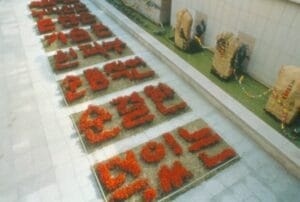
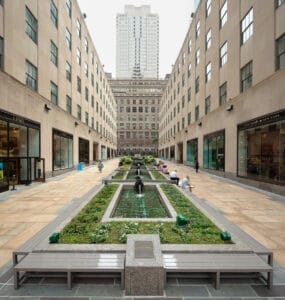
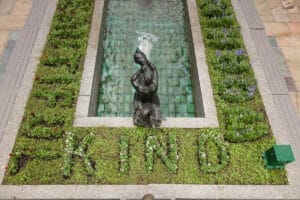
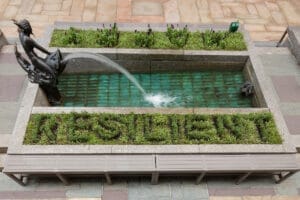


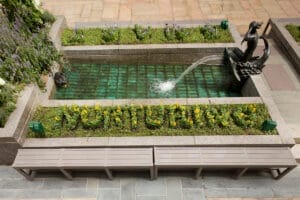
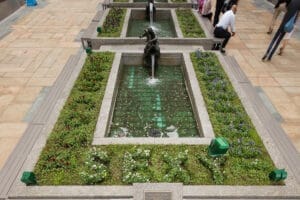
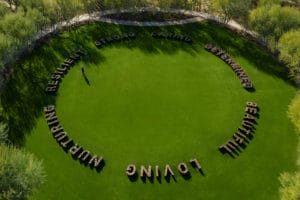
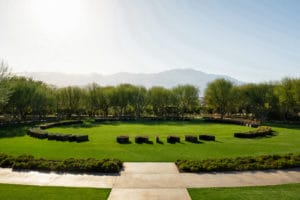
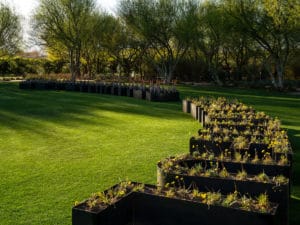
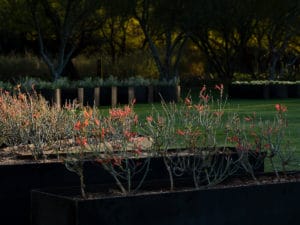
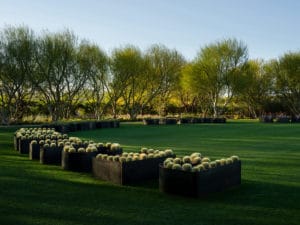
Versions
2000
Metropolitan Art Museum, Pusan, South Korea at Second Pusan Biennale, part of a group show: Leaving the Island, curated by Rosa Martinez, Young Chul and Hou Hanru
2020
Part of Frieze Sculpture The Rockefeller Center New York, NY, USA
2021
at Desert X, outdoor exhibit curated by Neville Wakefield and César García-Alvarez Sunnylands Center and Gardens, Coachela Valley Rancho Mirage, California, USA
Also shown at Ventura Botanical Garden Ventura, California, USA
Happily Ever After
The Happily Ever After garden consists of the familiar phrase that ends fairy tales: “happily ever after.” The words are spelled out in a circle using trimmed climbing roses and jasmine supported by a stainless steel structure roughly five feet high. The letters form a circular enclosure that surrounds a round teak bench where lovers (and visitors) can sit. When seated, however, one cannot read the entire sentence in one shot, but simply word by word, leading one to wonder about the inevitable ending of love stories and fairy tales.
The Happily Ever After garden was produced twice:
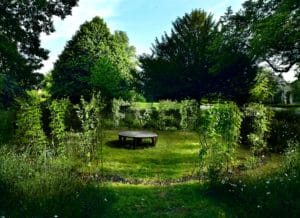
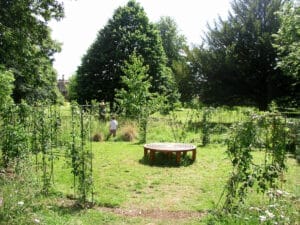


Versions
2005
Down the Garden Path, group show curated by Valerie Smith
Queens Museum of Art
Queens, New York, USA
And also at Sudeley Castle in Withcombe Gloucestershire, England
2009
Permanent Installation at the vineyard of Ornellia
Tenuta dell’Ornellaia, Bolgheri
Tuscany, Italy
And also at Prospect 1, New Orleans, USA
Il Était une Fois dans un Pays Lointain
[Once upon a Time in a Far Away Land]
This garden is a variation of Ghada Amer’s Happily Ever After Garden.
Versions
2007
Festival des Cultures Francophones: Faites vos jeux
Rennes, France
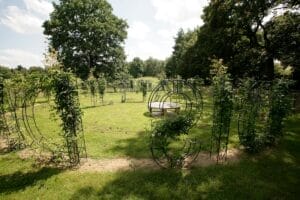
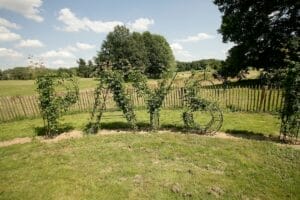
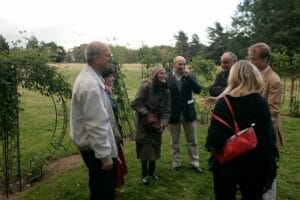

Love Park
Contrary to what one might think, “Love Park” is not a garden in the traditional sense with flowers and grass. Rather it is a romantic promenade through a garden with benches and signs.
For this project, Ghada Amer built 10 wooden benches and split each across the middle. Each half bench is positioned in an opposite direction, and faces a sign post with a citation from an internationally known author (Shakespeare, Rumi, Camus, Saint-Exupéry, Paglia, etc.), though all attribution has been purposely omitted. Visitors are invited to sit on any side of the bench and to read the citation facing them.
Unlike traditional love seats where partners sit next to each other and look together in the same direction toward the same future, in Ghada Amer’s garden, lovers are forced to sit on opposite sides and to look in different directions. Not least, each reads an unsigned quotation on love, visible only to her/him. Each set of quotations proposes contradictory messages, highlighting the inherent lack of communication and distance between couples. Love Park is a conversation in which lovers are unable to grasp the meaning of love.
The quotations Ghada Amer selected for this installation are slightly different in the English and in the French renditions of the park.
Bench 1
1a: It is not true that suffering ennobles the character; happiness does it sometimes. But suffering for the most part makes men petty and vindictive.
1b: Life will never be a utopian paradise of universal happiness, harmony and good will. Life is combat, strife, limitations, obstacles met and overcome by self-discipline and self-criticism.
Bench 2
2a: Men admire women who are healthy, of the right stature, with voluptuous flesh, and a light and glowing complexion. They smell good. Their shoulders are broad, their arms, long, their forearms fleshy. Their mouths are small with crimson-red lips that are soft, relaxed, generous, and plump. They have narrow and pleasing noses. They have noble faces which, in the opination of some, should be round in shape.
2b: Women admire men who show initiative, who are meticulously well groomed, who stand out in their social group and who have the best character, with a refined physical stature and pleasant features. They never lie when they speak to women and their words are truthful. These men are liberal, courageous, generous, and are easy to live with. When they say something, they mean it; and when they give their word, they honor it. These men can be trusted.
Bench 3:
3a: Reciprocity in love is false; it is only a mirage, a misunderstanding, a remission. To dream of mutual attachment is wrong and cowardly. If one honestly confronts the state of one’s melancholy, one would realize that feelings for not diminish but enhance the distance between human beings.
3b: Experience shows us that love does not consist in gazing at each other but looking at the same direction.
Bench 4
4a: I remained alone, disillusioned, as I always am whenever something has happened because its realization is always confusing, not precise enough, and is deprived of the greatness and purity hoped for.
4b: Of all the universal mysteries, love is by far the most complex. Love is close to the divine. Don’t laugh at that, Abou Sahl.
Bench 5
5a: Above all, no one is ever really happy. One aspires throughout one’s life to achieve an imagined happiness which one rarely attains. When one does attain it, one is disappointed. In general, one returns to port following the shipwreck with a disabled ship.
5b: Soft music shimmering like a blue lagoon,
Summer, night company and jasmine festoon.
Are all people happy, I wonder
And do they see the beauty of the moon.
Bench 6
6a: American Feminism has a man problem
6b: It is man who rules! Man does not ask if he pleases. If he is lovable. He is only concerned with his pleasure. His pleasure decides what is beautiful and what is ugly for him, and only for him. Man exists only for himself and for no one else.
Bench 7
7a: There is a word in many languages which designates both the acts of giving and of taking, charity and greed, doing good works and being covetous. That word is love.
7b: Tonight is the night; sad radiant;
When our mysteries are fulfilled
All my mysteries are images of you
Night be long!
He and I are lost in love.
Bench 8
8a: The man who is blamed by women has an extremely small instrument which goes soft most of the time, is thin and slow to be aroused. Women also dislike men who ejaculate prematurely, are slow to achieve climax, or whose chests are heavy to bear and whose rumps are incapable of supporting their partners’ s weight.
8b: Her voice was ever soft, gentle and low, and excellent thing in a woman.
Bench 9
9a: If you tame me, we will need each other. You will be for me someone unique and I will be someone unique for you.
9b: Offered to my mercy, infinitely fragile, as wrenching as a suspended wall, a face calls for my help and there is something imperious in this imploring; its misery elicits no pity from me; in demanding that I come to its aid, it aggresses me.
Bench 10
10a: She had always dreamed of a love in which her body and soul could grow old together, like two fingers of a hand.
10b: In love, only conquest and breaking-up are interesting; the rest is filler.
Bench 1
1a: Si tu m’apprivoises, nous aurons besoin l’un de l’autre. Tu seras pour moi unique au monde et je serai pour toi unique au monde.
1b: A ma merci, offert, infiniment fragile, déchirant comme un pleur suspend, le visage m’appelle au secours et il y a quelque chose d’impérieux dans cette imploration; sa misère ne me fait pas pitié; en m’ordonnant de lui venir en aide, elle me fait violence.
Bench 2
2a: Elle avait toujours rêvé d’un amour où son corps et son âme, comme deux doigts de la main auraient pu vieillir ensemble.
2b: En amour, il n’y a que la conquête et la rupture qui soient intéréssants; le reste n’est que remplissage.
Bench 3
3a: L’homme qui est loué chez les femmes est aussi celui qui manifeste de l’initiative, qui se tient toujours propre, qui surpasse par ses qualités ceux de son groupe social, qui a le meilleur caractère, celui dont la taille est fine et la physionomie agréable. Il ne ment jamais quand il parle à une femme et ses paroles correspondent à la verité. Il est liberal, brave, il a des sentiments généreux et un caractère facile à supporter. Quand il dit quelque chose, on peut le croire, et quand il promet, il tient parole. Il ne trahit pas la confiance qu’on met en lui.
3b: La femme qui est louée par les hommes est celle qui se porte bien physiquement, qui a une bonne stature, une chaire généreuse avec un teint blanc et brillant. Elle sentira bon; ses épaules seront éloignées l’une de l’autre; ses bras seront larges; les deux os de l’avant-bras renflés. Sa bouche sera étroite, avec des lèvres tendres d’une couleur rouge cramoisie, épaisses, chaudes, équilibrées, charnues. Elle aura un nez étroit et gracieux, des joues lisses d’un blanc éclatant, rehaussé de rose, de grands yeux. Son visage sera majestueux et, d’après certains, il devra être de forme ronde.
Bench 4
4a: L’amour ne nous habite jamais sans nous brûler. En parler, fût-ce après coup, n’est probablement possible qu’à partir de cette brûlure.
4b: L’amour est un acte sans importance puisqu’on peut le répéter indéfiniment.
Bench 5
5a: De tous les mystères de l’univers, l’amour est bien le plus complexe. L’amour est proche du divin. Il ne faut pas en rire Abou Sahl!
5b: Je resterai seul, désillusionné, comme il arrive chaque fois que quelque chose se réalise. Car la realisation est toujours trouble, insuffisamment precise, privée de la grandeur et de la pureté du projet.
Bench 6
6a: La réciprocité n’est pas la verité de l’amour, mais un mirage, un malentendu ou une remission. C’est à tort et par veulerie que l’on rêve d’attachement mutuel. Si l’homme affrontait avec franchise la mélancolie de sa condition, il saurait que le sentiment n’abolit pas mais creuse la distance entre les êtres.
6b: L’expérience nous montre que l’amour ne consiste pas à se regarder l’un l’autre mais à regarder ensemble dans la même direction.
Bench 7
7a: Celui qui est blamé par les femmes a un instrument extrêmement petit, qui se ramollit la plupart du temps, mince, lent à se lever. Les femmes trouvent désagréable aussi l’homme qui verse rapidement son liquide, celui dont le plaisir tarde à venir, celui dont la poitrine est lourde à supporter, dont la croupe est incapable de peser sa partenaire. Quand il s’approche de celle-ci, il ne s’en soucie pas, il ne s’applique pas.
7b: Sa voix était toujours tendre, douce et basse, une excellente chose chez la femme.
Bench 8
8a: Je t’enlacerai, tu t’en lasseras.
8b: Ma liberté s’appelle Amour. Elle a la forme d’un visage. Elle a le visage du bonheur
Bench 9
9a: Qu’est-ce que l’amour? Un accès de fièvre qui finit toujours par un baillement.
9b: All you need is love
Bench 10
10a: Est-ce cela l’amour, pouvoir respecter à l’infini les mêmes mots, uses, souillés par trop de bouches mais perçus par l’oreille de l’autre comme s’ils étaient neufs.
10b: Le front aux vitres comme font les veilleurs de chagrin
Je te cherche par delà l’attente
Par delà moi-même
Et je ne sais plus tant je t’aime
Lequel de nous deux est absent.
The Love Garden Installation was produced four times:
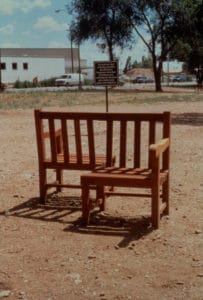
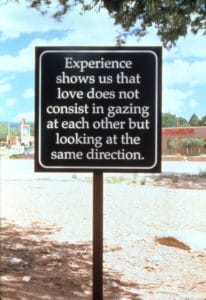


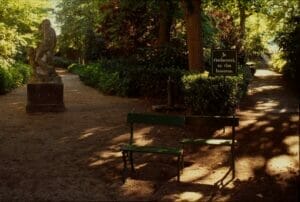

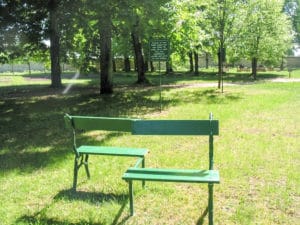
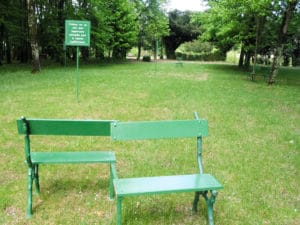
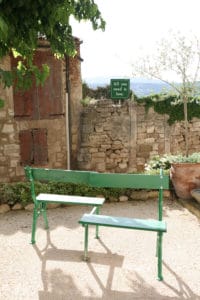
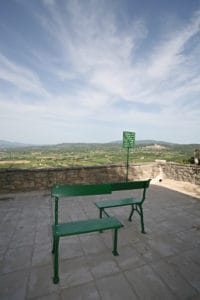
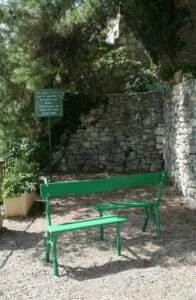


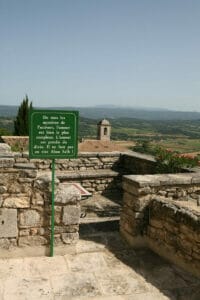
Versions
1999
Third International Biennial show: Looking For A Place, curated by Rosa Martinez
Site Santa Fe
Santa Fe, New Mexico
In this version, Ghada Amer’s allocated space was a plot of land near the exhibition center surrounded by a McDonald, a dilapidated railroad station and mountains in the far distance. This abandoned outdoor space drew homeless people with nowhere else to go.
2000
Solo show at the Centre de Création Contemporaine (CCC)
Jardin Musée des Beaux-Arts de Tours
Tours, France
2001
Parc du Château du Rivau
Léméré, France
2007
Afterglow, group show curated by Laurie Ann Farrell,
SCAD (Savannah College of Arts and Design)
Lacoste France
2023
Monterey, Mexico
Yin Yang
Ghada Amer’s Yin Yang Garden borrows the recognizable form of the oriental yin yang symbol that signifies equilibrium between the opposing but complimentary masculine and feminine primal cosmic forces of the universe. The garden is accessed through two narrow entrances that accommodate only one person at a time and contains a circular pond that houses frogs, fish and water lilies. The pond is bisected by a curving walkway of modulating widths, which at points allows viewers to traverse the pond in pairs and at other points only has the space to permit one person to pass. The design encourages participants to intimately engage with one another as they cross the water.
Versions
2005
Arsenale Main Exhibit: Always a Little Further, curated by Rosa Martinez
51st Venice Biennale (La Biennale di Venezia)
Venice, Italy


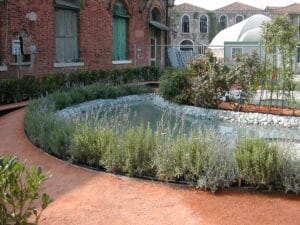

L’Espace à effeuiller les marguerites
Images to come
Images to come
Versions
1997
La Carte du Tendre exhibit, curated by Jany Bourdais.
Le Crestet Art Center,
Vaison-la-Romaine, France
2000
Parc du Château du Riveau,
Lémeré, France
